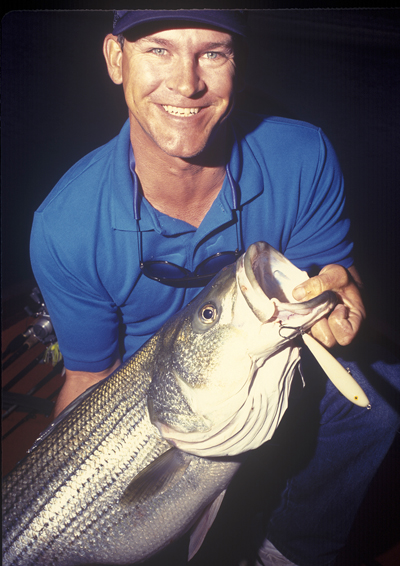
MIKE HASTINGS SHOWS HIS 22-POUND, four-ounce striped bass from Lake Travis. The state record is 53 pounds, caught in the Guadalupe River below Canyon Dam. (Photo by John Jefferson)
by John Jefferson
A friend, Bob Linder, told of his recent striped bass fishing jaunt on Lake Buchanan on the first really chilly day in Central Texas. The thermometer read “39 degrees.”
Linder said the trip across the lake was “a little breezy” – perhaps the understatement of the season. Linder, his wife, and son fished with striper guide, Max Milam.
He added that the three of them limited out with a 15-fish combination of stripers and hybrid stripers, and one large white bass, in just one hour! And, they caught them all at the first place they fished. The legal limit is five stripers, at least 18-inches long, per fisherman — not five stripers and five hybrids.
Lake Buchanan, and most large Texas lakes, has been heavily stocked with striped bass for years. Back during the drought, the Lake Buchanan Conservation Corporation, with their money, and permission from Texas Parks and Wildlife (TPW), began stocking the lake with hybrid stripers – female striped bass cross-bred in hatcheries with male white bass. The resulting hybrid is chunkier than pure striped bass, and well-suited for shallower, warmer lakes than the deep, open water lakes required for the pure breeds. Physically, they look alike to casual observers. Generally, pure stripers are long and slender, as opposed to hybrids, which one guide describes as “little footballs.” Stripes on the true stripers are distinct and several extend to the tail. Hybrids’ stripes are broken.
Both striped bass and hybrids have two rough “tooth patches” on the backs of their tongues. Hybrids are shaped more like white bass, which only have one tooth patch. The TPW Outdoor Annual – the regulations pamphlet — has illustrations and descriptions on page 38.
It wasn’t surprising that stripers turned on with the cold front that morning. The species originated in cold water, and prefer it. In Lake Buchanan – and other large lakes — both stripers and hybrids exist and are often caught on the same trip. Milam said the Linders boated 12 hybrids and three pure stripers.
Neither variety will pass up sunfish or small bass, but usually dine – and gorge – on shad, considering it more economical to chase large schools. More bait to the bite! They don’t feed as voraciously during the summer as they do in the fall and winter, preferring instead to hang deep in the coldest, oxygenated water.
Running the catch-dates of the top 50 stripers caught in Texas, it’s apparent the big ‘uns were caught from February through May after stuffing shad all winter. Females are also heavy with eggs, then. Stripers aren’t known to spawn in Texas, except in Lake Texoma and perhaps in the Red River, but egg sacks could develop, adding weight.
The best bait is live shad, although some are caught every year on artificial lures. Max Milam’s father, Ken, was a pioneer striper guide, and has often said, “It’s more productive to feed ‘em, rather than try to fool ‘em!”
After removing any red meat from the filets, they’re fine eating.




